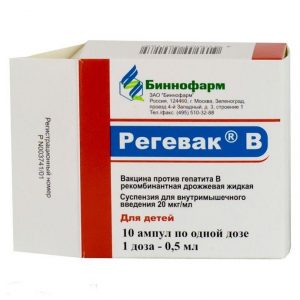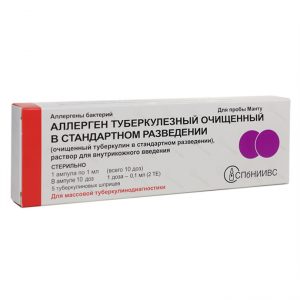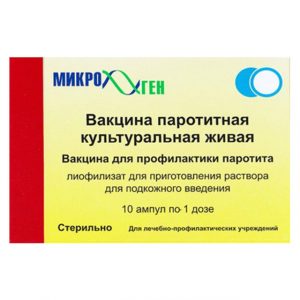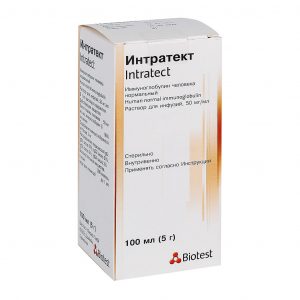Description
Release form
Enteric-coated tablets
Packing
100 pcs.
Pharmacological action
MAYFORTIK – immunosuppressive drug. Mayfortic inhibits the synthesis of guanosine nucleotides by selectively inhibiting the key enzyme for the synthesis of purines, inosine monophosphate dehydrogenase. Thanks to this mechanism, it effectively inhibits the proliferation of T and B lymphocytes, and to a much greater extent than other cells, since the proliferation of lymphocytes depends mainly on the synthesis of purines de novo. The mechanism of action of Mayfortica complements the mechanism of action of calcineurin inhibitors, disturbing the production of cytokines and affecting T-lymphocytes in the resting phase of the cell cycle.
Indications
Prevention of acute transplant rejection in patients with allogeneic kidney transplants receiving basic immunosuppressive therapy with cyclosporine in the form of microemulsions and corticosteroids.
Contraindications
Hypersensitivity to sodium mycophenolate, mycophenolic acid, mycophenolate mofetil or any other component of Mayfortic.
With caution, the drug should be prescribed for congenital insufficiency of hypoxanthine-guanine-phosphoribosyltransferase (including with Lesch-Nyhen and Kelly-Sigmiller syndromes), gastrointestinal diseases in the acute phase.
Use during pregnancy and lactation
Use of Mayfortik during pregnancy is possible only when the intended benefits to the mother outweigh the potential risk to the fetus.
It is not known whether IFC is excreted in breast milk. Due to the fact that there is a potential risk of serious adverse events in a nursing baby under the influence of sodium mycophenolate, it is necessary to resolve the issue of either discontinuing the use of Mayfortic, or, given the importance of therapy with this drug for the mother, stopping breastfeeding throughout the course of treatment and within 6 weeks after its termination.
Special instructions
The drug should be administered by qualified transplant doctors only. In patients receiving combination immunosuppressive therapy, including and mycophenolic acid, the risk of developing lymphomas and other malignant tumors, especially the skin, is increased. This risk is most likely associated with the intensity and duration of immunosuppressive therapy. To reduce the effects of sunlight and UV radiation (reducing the risk of developing skin cancer), it is recommended that you protect your skin with clothing and use sunscreens with a high degree of protection. Patients receiving therapy with the drug should immediately inform the doctor about all cases of infection, the appearance of hematomas, bleeding, and any other manifestations of inhibition of bone marrow function. Excessive immunosuppression increases the likelihood of developing infections, including opportunistic and fatal infections, as well as sepsis. In patients receiving drug therapy, the development of neutropenia is not excluded, due to both exposure to mycophenolic acid itself and the concomitant therapy of other drugs, viral infections, or a combination of these factors. During the treatment period, the number of leukocytes and the blood formula should be regularly determined: during the first month of therapy – weekly, during the second and third months – 2 times a month, then, during the first year – 1 time per month. With the development of neutropenia (the absolute number of neutrophils is less than 1500 / Ñl), it is advisable to interrupt or stop the therapy. Careful monitoring of patients with severe chronic renal failure (glomerular filtration rate less than 25 ml x 1.73 sq / min) is necessary. Patients should be warned that vaccination may be less effective during therapy and that live attenuated vaccines should be avoided. Influenza vaccination may be useful for patients, therefore, local authorities should be advised in this matter regarding influenza vaccination. The drug was used in combination with the following drugs: antithymocytic globulin, basiliximab, cyclosporine (microemulsion) and corticosteroids. Efficacy and safety in its use with other immunosuppressive drugs has not been studied. Limited pharmacokinetic data are available in children undergoing kidney transplantation. At the moment, specific recommendations on the dosage regimen in children have not been developed. Since there have been no controlled clinical trials of the use of the drug in pregnant women, the appointment during lactation is possible only when the expected effect of therapy for the mother outweighs the possible risk to the fetus. In experimental models, cases of undesirable effects on fetal development, including malformations, were noted. It is not recommended to start therapy until a negative pregnancy test is obtained. In case of pregnancy, the patient should immediately consult a doctor. Before the start of therapy, throughout the course of therapy and within 6 weeks after its completion, reliable methods of contraception should be used. It is not known whether the drug is excreted in breast milk. It is necessary to consider the termination of breastfeeding throughout the course of therapy and within 6 weeks after its termination. During the treatment period, caution must be exercised when driving vehicles and engaging in potentially hazardous activities that require an increased concentration of attention and speed of psychomotor reaction.
Composition
Active ingredient: mycophenolic acid 360 mg.
Excipients: povidone (K-30), crospovidone, corn starch, anhydrous lactose, colloidal silicon dioxide, magnesium stearate.
Shell: hypromellose phtholate, titanium dioxide, iron oxide yellow / iron oxide red.
Dosage and administration
Inside (swallowing whole, without chewing or breaking), on an empty stomach or with a meal.
Mayfortic therapy in patients who have not received it before begins in the first 48 hours after transplantation. The recommended dose is 720 mg (2 tablets of 360 mg) 2 times / day, the daily dose is 1440 mg. For patients receiving mycophenolate mofetil (MMF) at a dose of 2 g / day, MMF can be replaced by Mayfortic at a dose of 720 mg 2 times / day.
Correction of the dosage regimen in elderly patients is not required.
In patients with delayed restoration of renal transplant function, dose adjustment of Mayfortic is not required.
In patients with severe liver disease associated with a predominant lesion of the parenchyma, dose adjustment of Mayfortic is not required.
Graft rejection reaction does not lead to a change in the pharmacokinetics of IFC. In these cases, changes in the dosage regimen are not required.
Side effects of
When using Mayfortik in combination with cyclosporine and glucocorticosteroids, undesirable effects such as leukopenia and diarrhea were very often observed (> = 10%).
Malignant neoplasms. In patients receiving immunosuppressive therapy with several drugs, including IFC increased risk of developing lymphomas and other neoplasms, in particular, the skin. Lymphoproliferative diseases or lymphomas developed in 0.3% of patients who received Mayfortic for 1 year as part of complex immunosuppressive therapy. Non-melanoma skin carcinomas occurred in 0.8% of patients.
Infectious diseases (opportunistic infections). In patients with a first transplanted kidney who received Myfortic for 1 year as part of complex immunosuppressive therapy, the most common cytomegalovirus (CMV) infections, candidiasis, and herpes simplex virus infection were most often observed. CMV infection (confirmed serologically, by viremia or clinical data) was observed in 21.6% of patients with a recently transplanted kidney and in 1.9% of patients with a stable functioning transplant on long-term maintenance therapy. Listed below are adverse events that occur with a frequency of 1 to 10% or more than 10%, presumably associated with taking IFC.
Infections and infestations: often – urinary tract infections, herpes zoster, candidiasis of the oral mucosa, sinusitis, upper respiratory tract infections, gastroenteritis, herpes simplex virus infections, nasopharyngitis.
From the hemopoietic system: very often – leukopenia often – anemia, thrombocytopenia.
From the nervous system: often – headache.
From the respiratory system: often – cough.
From the digestive system: very often – diarrhea often – nausea, vomiting, dyspepsia, gastritis, constipation, abdominal pain, bloating, flatulence, loose stools, abdominal pain on palpation, gastritis.
On the part of the body as a whole: often – hyperthermia, fatigue.
On the part of laboratory parameters: often – a deviation from the norm of liver function indicators, hypercreatininemia.
The following side effects were observed while taking drugs containing mycophenolic acid as an active substance (class effects):
From the digestive system: colitis (including CMV colitis), esophagitis (including CMV esophagitis) CMV gastritis, pancreatitis, perforation of the intestinal wall, gastrointestinal bleeding, gastric and / or duodenal ulcer, intestinal obstruction.
Phenomena associated with immunosuppression: severe infectious diseases, sometimes life-threatening, including meningitis, infectious endocarditis, tuberculosis, atypical infections caused by mycobacteria.
From the hemopoietic system: neutropenia, pancytopenia.
Drug interactions
In chronic renal failure, concentrations in the blood of both HMPA and acyclovir may increase (a similar excretion route is canalic secretion). Such patients require close monitoring. The addition of ganciclovir does not affect the pharmacokinetics of mycophenolic acid and HMPA. Upon reaching a therapeutic concentration of mycophenolic acid, the clearance of ganciclovir does not change. However, when combined with ganciclovir, patients with chronic renal failure may need to adjust the dosage regimen of ganciclovir, and such patients should be closely monitored. Antacids containing magnesium and aluminum hydroxide. With simultaneous administration with antacids containing Mg2 +, Al3 +, the absorption of mycophenolic acid decreases, as a result of which AUC decreases by 37% and Cmax – by 25%. Azathioprine should not be given at the same time. Against the background of equilibrium concentrations of mycophenolic acid, the pharmacokinetics of cyclosporin A does not change. In connection with its ability to bile bile acids in the intestine, colestyramine, etc. drugs that affect the circulation of bile acids can reduce the concentration and AUC of mycophenolic acid. The effect of oral contraceptives on the pharmacokinetics of Mifortic is unlikely, however, the effect of long-term drug therapy on the pharmacokinetics of oral contraceptives has not yet been studied, the possibility of a decrease in the effectiveness of contraceptives cannot be ruled out. Live vaccines should not be used in patients with immunosuppression. When using other vaccines, the production of antibodies can be reduced.
Storage Conditions
In a dark place at a temperature not exceeding 25 ° C.
The Expiration of
is 2.5 years.
active substance
mycophenolic acid
Terms leave through pharmacies
In retseptu
Dosage form
tablet




